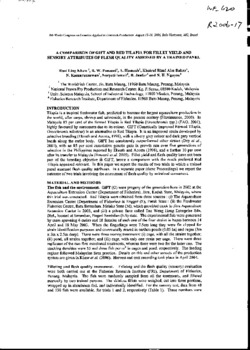A comparison of GIFT and red tilapia for fillet yield and sensory attributes of flesh quality assessed by trained panel
Abstract
Tilapia is a tropical freshwater fish, predicted to become the largest aquaculture production in the world, after carps, shrimp and salmonids, in the present century (Fitzsimmons, 2000). In Malaysia 85 per cent of the farmed Tilapia is Red Tilapia (Oreochromis spp.) (FAO, 2001), highly favoured by consumers due to its colour. GIFT (Genetically Improved Farmed Tilapia, Oreochromis niloticus) is an alternative to Red Tilapia. It is an improved strain developed by selective breeding (Eknath and Acosta, 1998), with a silvery grey colour and dark grey vertical bands along the entire body. GIFT has consistently outperformed other strains (Dey et al., 2001), with an 85 per cent cumulative genetic gain in growth rate over five generations of selection in the Philippines reported by Eknath and Acosta (1998), and a further 10 per cent after its transfer to Malaysia (Ponzoni et al. 2005). Fillet yield and flesh quality have not been part of the breeding objective in GIFT, hence a comparison with the much preferred Red Tilapia appeared relevant. In this paper we report the results of two trials in which a trained panel assessed flesh quality attributes. In a separate paper (these Proceedings) we report the outcome of two trials involving the assessment of flesh quality by untrained consumers

